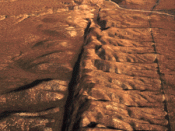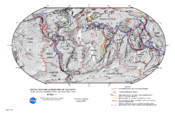We usually regard our Earth as a symbol of solidity. To us, it is the soil on which we stand firmly with our two legs, the bedrock for our buildings and their reliable foundations. But this solid bedrock is only a thin crust about 100 km thick. The material underneath, in the earth's mantle, reacts plastically, like paste. In places where it reaches the surface, as in volcanoes, it may even become fluid and flow out as lava. However, the mantle material as a whole is moving, too, if only by a matter of centimeters a year, dragging the brittle crust above it along with it. Because of its movements in different directions the brittle part, called the lithosphere, breaks into pieces of various dimensions.
The biggest of these, the so-called plates, may move apart, as often happens underneath the central parts of our oceans. At what is known as their divergent plate boundaries, this results in provinces of active volcanism and minor earthquakes, for example in Iceland.
If the plates pass each other in a strike-slip fashion, earthquakes may occur, as around the San Andreas Fault in California. In the convergent plate boundary regions, one plate normally plunges underneath its neighboring plate and finally reaches the earth's mantle, where it is incorporated again. Many active volcanoes and some major earthquakes occur around these "subduction zones." The Pacific, for example, is surrounded by convergent plate boundaries which form a volcanic "ring of fire."
For three decades, the theory of plate tectonics has enabled us to explain the origin and distribution of many volcanic eruptions and earthquakes. It has also provided initial data which can provide regional warnings of such natural disasters.
Projections suggest a global population of more than 10 billion for the beginning of the next century. From a...


